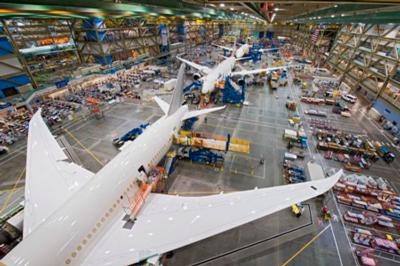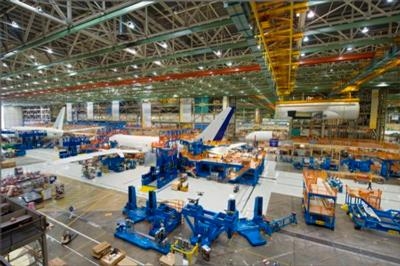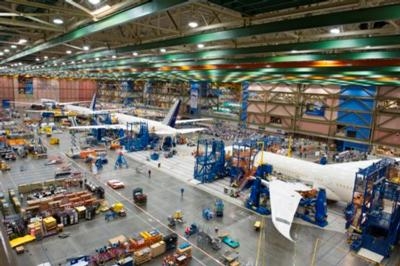Tue, Nov 13, 2012
Now Rolling Off The Assembly Line At Five Airplanes Per Month
Boeing has rolled out the first 787 Dreamliner built at the new rate of five airplanes per month. The airplane is the 83rd 787 to be built. Earlier this year, the planemaker increased the rate from 2.5 to 3.5 airplanes per month, and is on track to achieve a planned 10-per-month rate by late 2013. The program production rate accounts for airplanes built at Boeing South Carolina and Everett, including the Temporary Surge Line that was activated earlier this year in Everett.

"This accomplishment, doubling our production rate in one year, is the result of the combined efforts of thousands of men and women across Boeing and at our partners," said Larry Loftis, vice president and general manager of the 787 program. "The entire 787 team is focused on meeting our commitments. They've gotten even smarter in how they build this airplane and applied real ingenuity in making our processes and tools more efficient."
Boeing employees are using teamwork and new technologies to meet production rate increases. Approximately 500 employee involvement teams are actively pursuing improvement efforts across the program. Teams are led by employees working to find ways to improve efficiency, quality, safety and growth.
As just one example illustrative of the efforts happening across the production system, a team developed a small piece of protective equipment to cover the electronic actuators that help move the horizontal stabilizer. The plastic covering is now used across the program to protect the actuators during the production process. In addition, this small change has resulted in quicker production completion times.
"The work our teams are doing to continuously improve is making this program more efficient," added Loftis. "Their commitment to doing the job with high quality and making improvements to the system is outstanding."
Among the new tools being deployed to improve productivity in the Final Assembly areas are Orbital Drilling machines. The machines are used to drill holes to attach the wings to the center fuselage section of the airplane. The drilling technique is unique in that the cutter rotates in a circular motion to carve out the hole, rather than a conventional drill that cuts straight into the material. Benefits of the machines include improved precision and time savings for mechanics. A third benefit is improved safety as the machines require lower thrust and torque.
(Images provided by Boeing)


More News
Bolen Issues Statement Reinforcing Need To Reopen Government The National Business Aviation Association’s President and CEO issued the statement below in response to further >[...]
Output May Reach Its Best Since 2018 Despite Trailing Behind Airbus Boeing delivered 53 jets in October, bringing its 2025 total to 493 aircraft and marking its strongest output si>[...]
Low-Cost Airline Admits “Substantial Doubt” It Can Stay Airborne Spirit Airlines has once again found itself in financial trouble, this time less than a year after clai>[...]
Travelers Leaving Changi Will Soon Pay for Sustainable Fuel Starting April 2026, passengers flying out of Singapore will find a new fee tucked into their tickets: a Sustainable Avi>[...]
Pilot Was Having Difficulty Controlling The Airplane’S Rudder Pedals Due To His Physical Stature Analysis: The pilot was having difficulty controlling the airplane’s ru>[...]
 NBAA Responds To GA/BA Operational Restrictions
NBAA Responds To GA/BA Operational Restrictions Boeing Deliveries Surge to Pre-Pandemic Levels
Boeing Deliveries Surge to Pre-Pandemic Levels Spirit Forecasts Financial Turbulence
Spirit Forecasts Financial Turbulence Singapore Adds a Price Tag to Going Green
Singapore Adds a Price Tag to Going Green NTSB Final Report: Arlie L Raber III Challenger 1
NTSB Final Report: Arlie L Raber III Challenger 1





